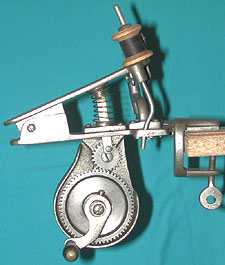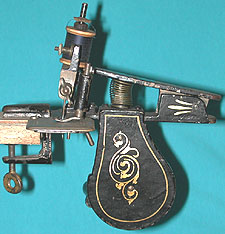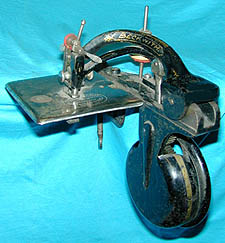|
Beckwith.
William
Gould Beckwith's first model was patented in both the USA and
UK in 1871. The chain stitch design was both simple and elegant.
An arm projecting from the lower lever formed the workplate. Below
this, a horizontal vibrating looper was mounted, this being actuated
by a curved arm projecting downward from the upper lever, and
working in a slot in the looper. Fabric feed was achieved by the
action of a bent needle with a curvature greater than that of
the curve in which the needle holder moved - the downward stroke
drawing the work forward. A toothed presser foot was employed
to prevent reverse fabric movement on the needle upstroke.
The "ring pull" used to power the machine quickly proved impractical
in use.
Within months, a geared hand-crank arrangement superseded the
first model. Unlike most machines, the crank could be turned in
either direction without affecting operation. With confidence
in the machine re-established, and an unaltered price of $10,
sales soared. By 1874 an all-new model had been patented. Known
today as the "Cross-arm," the heavily constructed machine used
extra engineering to overcome some of the earlier model's weaknesses,
this being particularly evident in the feed motion geometry. The
buying public certainly approved and sales at least equalled those
of the earlier model. Manufactured in New York, USA, initially
by Barlow & Son, and later by the Beckwith Sewing Machine Co.,
the machines also enjoyed buoyant export sales to Europe for several
years.
See
patents.
G.D.
Oct. 2000
|
 The
improved geared hand crank setup
The
improved geared hand crank setup
can clearly be seen in this
nickel plated example.
|
 A japanned
and gilded version was
A japanned
and gilded version was
also marketed.
|
 The
completely redesigned
The
completely redesigned
final incarnation.
|
|





